Rainwater Tank Savings in Australia: Cost-Effectiveness and Benefits
VerifiedAdded on 2020/05/08
|33
|8151
|50
Report
AI Summary
This report examines the use and benefits of rainwater tanks in Australian households, focusing on their role as an alternative water source and their contribution to water conservation. The study analyzes the cost-effectiveness of rainwater tanks, considering factors like tank size, roof size, climate, and government rebate schemes. Data collected from surveys of Australian households, including those with and without rainwater tanks, is used to assess water savings, payback periods, and the impact on water demand. The report also includes a levelized cost analysis, average daily consumption analysis, and recommendations for improving rainwater tank adoption. The findings demonstrate the significant potential of rainwater tanks to reduce household water consumption, offering both environmental and economic benefits. The report provides detailed information and analysis on the savings, cost and environmental benefits to the house owners and the government.
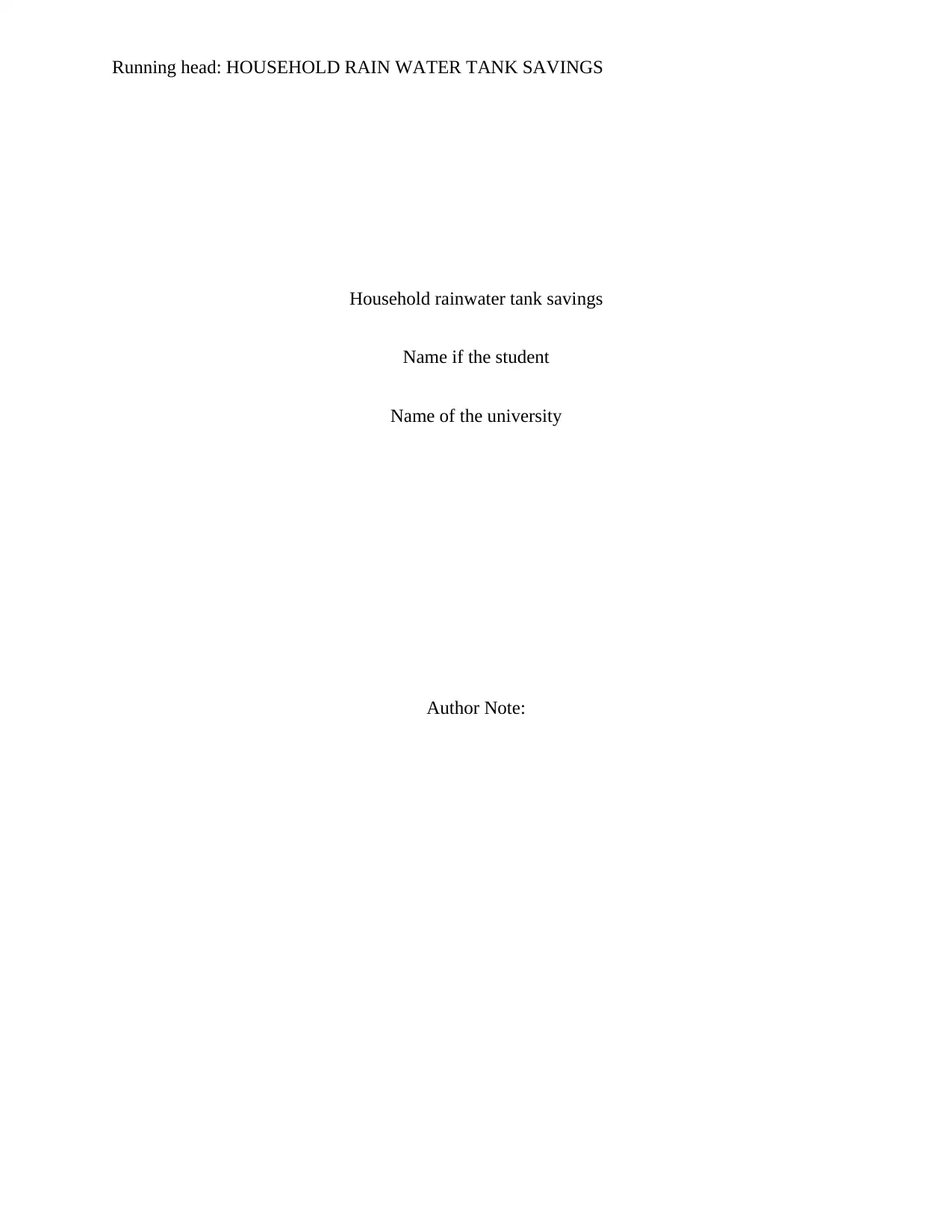
Running head: HOUSEHOLD RAIN WATER TANK SAVINGS
Household rainwater tank savings
Name if the student
Name of the university
Author Note:
Household rainwater tank savings
Name if the student
Name of the university
Author Note:
Paraphrase This Document
Need a fresh take? Get an instant paraphrase of this document with our AI Paraphraser
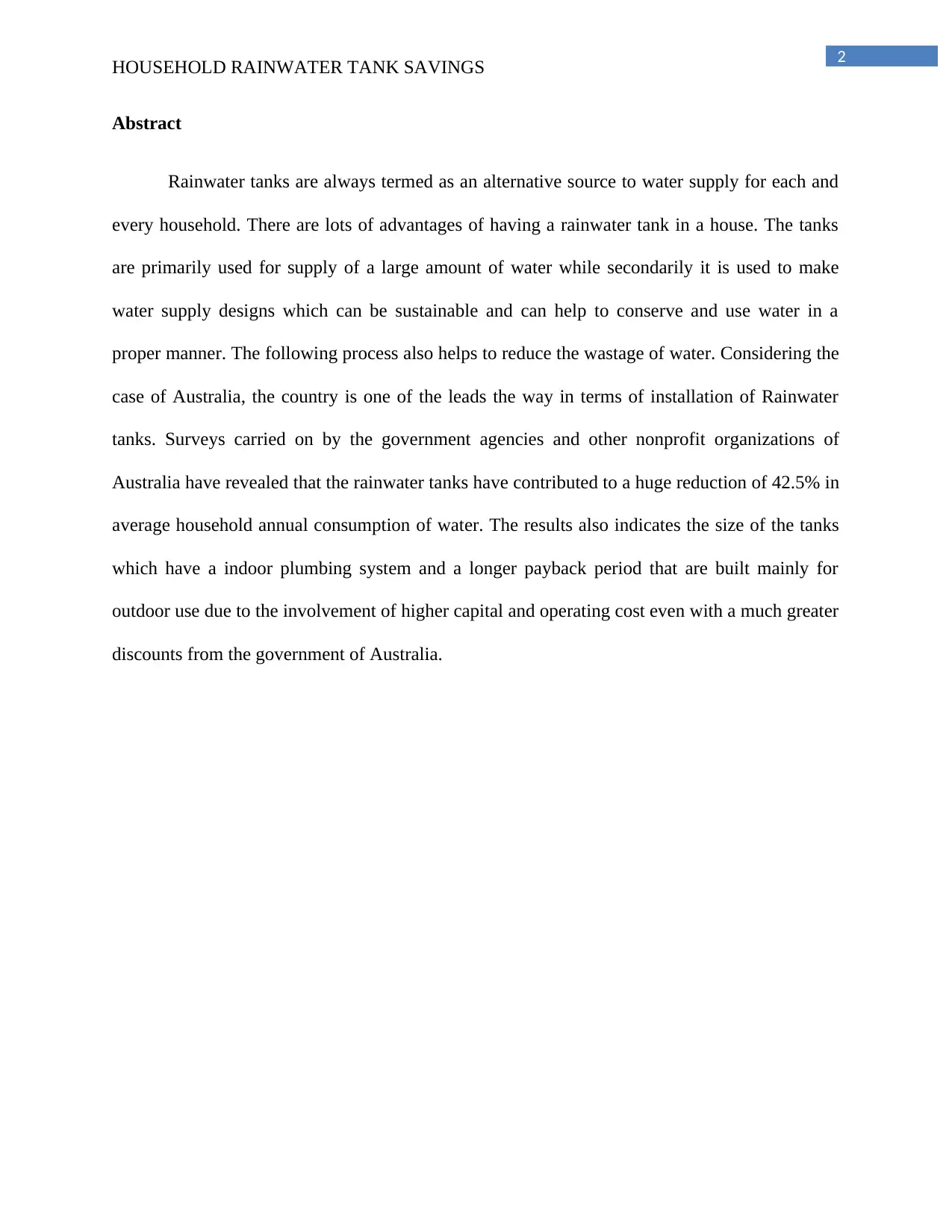
2
HOUSEHOLD RAINWATER TANK SAVINGS
Abstract
Rainwater tanks are always termed as an alternative source to water supply for each and
every household. There are lots of advantages of having a rainwater tank in a house. The tanks
are primarily used for supply of a large amount of water while secondarily it is used to make
water supply designs which can be sustainable and can help to conserve and use water in a
proper manner. The following process also helps to reduce the wastage of water. Considering the
case of Australia, the country is one of the leads the way in terms of installation of Rainwater
tanks. Surveys carried on by the government agencies and other nonprofit organizations of
Australia have revealed that the rainwater tanks have contributed to a huge reduction of 42.5% in
average household annual consumption of water. The results also indicates the size of the tanks
which have a indoor plumbing system and a longer payback period that are built mainly for
outdoor use due to the involvement of higher capital and operating cost even with a much greater
discounts from the government of Australia.
HOUSEHOLD RAINWATER TANK SAVINGS
Abstract
Rainwater tanks are always termed as an alternative source to water supply for each and
every household. There are lots of advantages of having a rainwater tank in a house. The tanks
are primarily used for supply of a large amount of water while secondarily it is used to make
water supply designs which can be sustainable and can help to conserve and use water in a
proper manner. The following process also helps to reduce the wastage of water. Considering the
case of Australia, the country is one of the leads the way in terms of installation of Rainwater
tanks. Surveys carried on by the government agencies and other nonprofit organizations of
Australia have revealed that the rainwater tanks have contributed to a huge reduction of 42.5% in
average household annual consumption of water. The results also indicates the size of the tanks
which have a indoor plumbing system and a longer payback period that are built mainly for
outdoor use due to the involvement of higher capital and operating cost even with a much greater
discounts from the government of Australia.
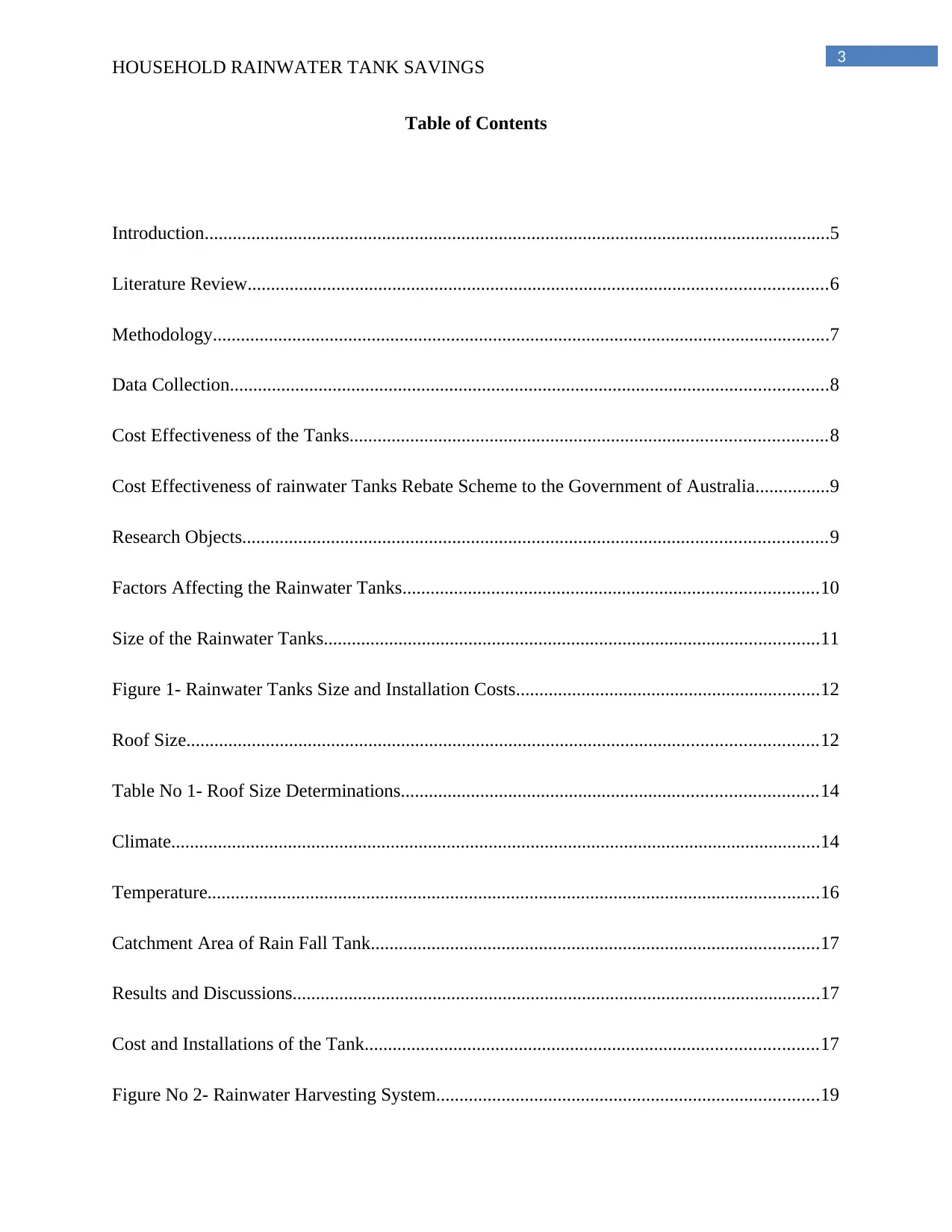
3
HOUSEHOLD RAINWATER TANK SAVINGS
Table of Contents
Introduction......................................................................................................................................5
Literature Review............................................................................................................................6
Methodology....................................................................................................................................7
Data Collection................................................................................................................................8
Cost Effectiveness of the Tanks......................................................................................................8
Cost Effectiveness of rainwater Tanks Rebate Scheme to the Government of Australia................9
Research Objects.............................................................................................................................9
Factors Affecting the Rainwater Tanks.........................................................................................10
Size of the Rainwater Tanks..........................................................................................................11
Figure 1- Rainwater Tanks Size and Installation Costs.................................................................12
Roof Size.......................................................................................................................................12
Table No 1- Roof Size Determinations.........................................................................................14
Climate...........................................................................................................................................14
Temperature...................................................................................................................................16
Catchment Area of Rain Fall Tank................................................................................................17
Results and Discussions.................................................................................................................17
Cost and Installations of the Tank.................................................................................................17
Figure No 2- Rainwater Harvesting System..................................................................................19
HOUSEHOLD RAINWATER TANK SAVINGS
Table of Contents
Introduction......................................................................................................................................5
Literature Review............................................................................................................................6
Methodology....................................................................................................................................7
Data Collection................................................................................................................................8
Cost Effectiveness of the Tanks......................................................................................................8
Cost Effectiveness of rainwater Tanks Rebate Scheme to the Government of Australia................9
Research Objects.............................................................................................................................9
Factors Affecting the Rainwater Tanks.........................................................................................10
Size of the Rainwater Tanks..........................................................................................................11
Figure 1- Rainwater Tanks Size and Installation Costs.................................................................12
Roof Size.......................................................................................................................................12
Table No 1- Roof Size Determinations.........................................................................................14
Climate...........................................................................................................................................14
Temperature...................................................................................................................................16
Catchment Area of Rain Fall Tank................................................................................................17
Results and Discussions.................................................................................................................17
Cost and Installations of the Tank.................................................................................................17
Figure No 2- Rainwater Harvesting System..................................................................................19
⊘ This is a preview!⊘
Do you want full access?
Subscribe today to unlock all pages.

Trusted by 1+ million students worldwide
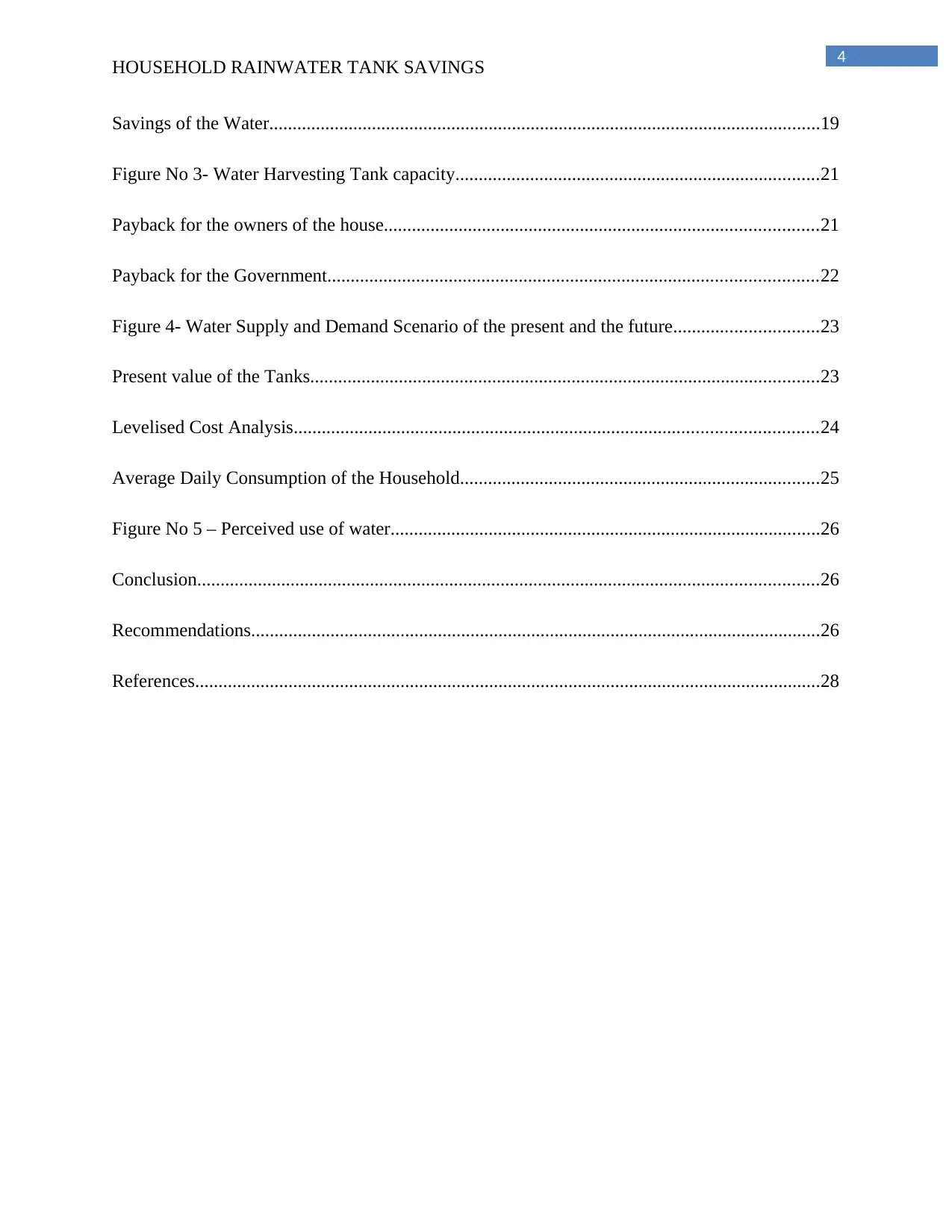
4
HOUSEHOLD RAINWATER TANK SAVINGS
Savings of the Water......................................................................................................................19
Figure No 3- Water Harvesting Tank capacity..............................................................................21
Payback for the owners of the house.............................................................................................21
Payback for the Government.........................................................................................................22
Figure 4- Water Supply and Demand Scenario of the present and the future...............................23
Present value of the Tanks.............................................................................................................23
Levelised Cost Analysis................................................................................................................24
Average Daily Consumption of the Household.............................................................................25
Figure No 5 – Perceived use of water............................................................................................26
Conclusion.....................................................................................................................................26
Recommendations..........................................................................................................................26
References......................................................................................................................................28
HOUSEHOLD RAINWATER TANK SAVINGS
Savings of the Water......................................................................................................................19
Figure No 3- Water Harvesting Tank capacity..............................................................................21
Payback for the owners of the house.............................................................................................21
Payback for the Government.........................................................................................................22
Figure 4- Water Supply and Demand Scenario of the present and the future...............................23
Present value of the Tanks.............................................................................................................23
Levelised Cost Analysis................................................................................................................24
Average Daily Consumption of the Household.............................................................................25
Figure No 5 – Perceived use of water............................................................................................26
Conclusion.....................................................................................................................................26
Recommendations..........................................................................................................................26
References......................................................................................................................................28
Paraphrase This Document
Need a fresh take? Get an instant paraphrase of this document with our AI Paraphraser
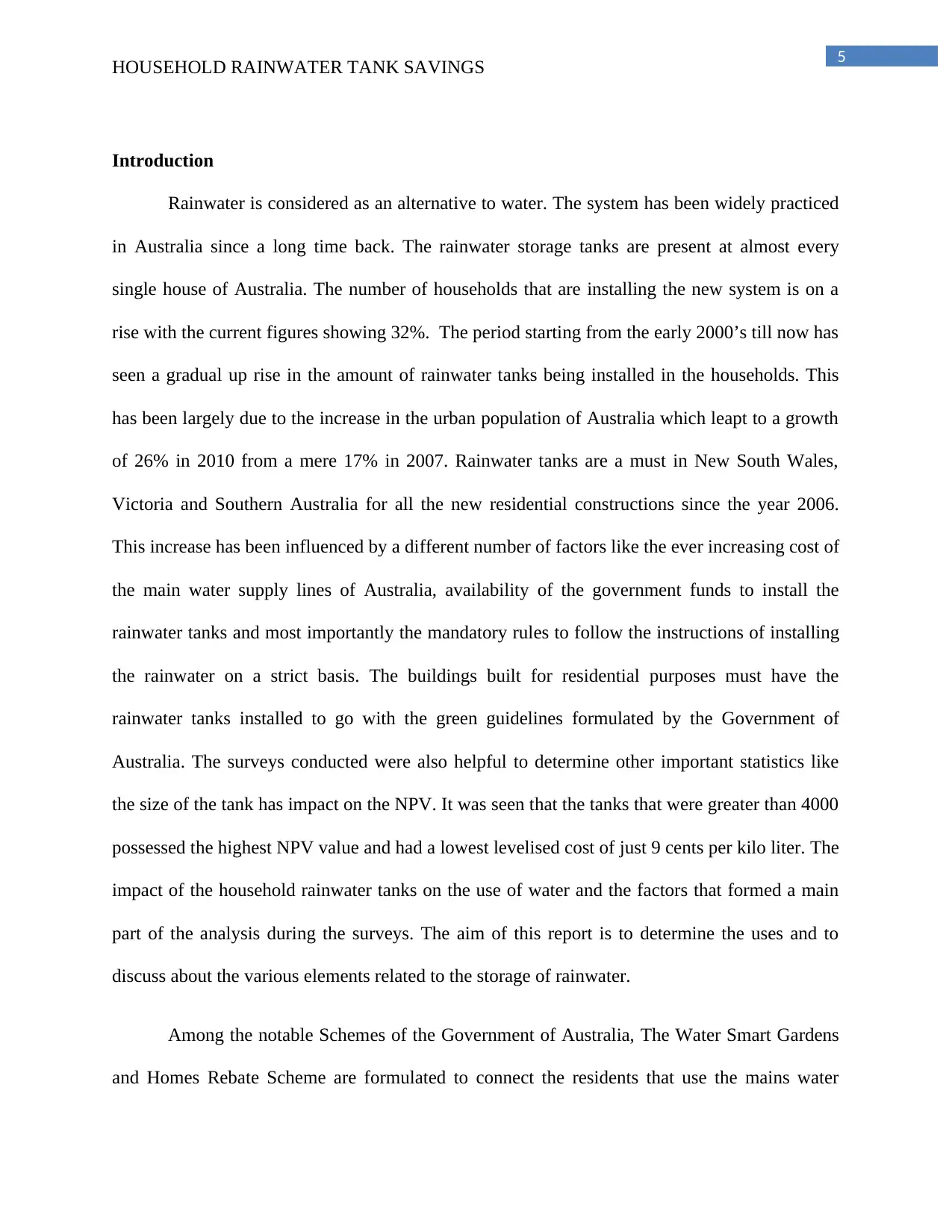
5
HOUSEHOLD RAINWATER TANK SAVINGS
Introduction
Rainwater is considered as an alternative to water. The system has been widely practiced
in Australia since a long time back. The rainwater storage tanks are present at almost every
single house of Australia. The number of households that are installing the new system is on a
rise with the current figures showing 32%. The period starting from the early 2000’s till now has
seen a gradual up rise in the amount of rainwater tanks being installed in the households. This
has been largely due to the increase in the urban population of Australia which leapt to a growth
of 26% in 2010 from a mere 17% in 2007. Rainwater tanks are a must in New South Wales,
Victoria and Southern Australia for all the new residential constructions since the year 2006.
This increase has been influenced by a different number of factors like the ever increasing cost of
the main water supply lines of Australia, availability of the government funds to install the
rainwater tanks and most importantly the mandatory rules to follow the instructions of installing
the rainwater on a strict basis. The buildings built for residential purposes must have the
rainwater tanks installed to go with the green guidelines formulated by the Government of
Australia. The surveys conducted were also helpful to determine other important statistics like
the size of the tank has impact on the NPV. It was seen that the tanks that were greater than 4000
possessed the highest NPV value and had a lowest levelised cost of just 9 cents per kilo liter. The
impact of the household rainwater tanks on the use of water and the factors that formed a main
part of the analysis during the surveys. The aim of this report is to determine the uses and to
discuss about the various elements related to the storage of rainwater.
Among the notable Schemes of the Government of Australia, The Water Smart Gardens
and Homes Rebate Scheme are formulated to connect the residents that use the mains water
HOUSEHOLD RAINWATER TANK SAVINGS
Introduction
Rainwater is considered as an alternative to water. The system has been widely practiced
in Australia since a long time back. The rainwater storage tanks are present at almost every
single house of Australia. The number of households that are installing the new system is on a
rise with the current figures showing 32%. The period starting from the early 2000’s till now has
seen a gradual up rise in the amount of rainwater tanks being installed in the households. This
has been largely due to the increase in the urban population of Australia which leapt to a growth
of 26% in 2010 from a mere 17% in 2007. Rainwater tanks are a must in New South Wales,
Victoria and Southern Australia for all the new residential constructions since the year 2006.
This increase has been influenced by a different number of factors like the ever increasing cost of
the main water supply lines of Australia, availability of the government funds to install the
rainwater tanks and most importantly the mandatory rules to follow the instructions of installing
the rainwater on a strict basis. The buildings built for residential purposes must have the
rainwater tanks installed to go with the green guidelines formulated by the Government of
Australia. The surveys conducted were also helpful to determine other important statistics like
the size of the tank has impact on the NPV. It was seen that the tanks that were greater than 4000
possessed the highest NPV value and had a lowest levelised cost of just 9 cents per kilo liter. The
impact of the household rainwater tanks on the use of water and the factors that formed a main
part of the analysis during the surveys. The aim of this report is to determine the uses and to
discuss about the various elements related to the storage of rainwater.
Among the notable Schemes of the Government of Australia, The Water Smart Gardens
and Homes Rebate Scheme are formulated to connect the residents that use the mains water
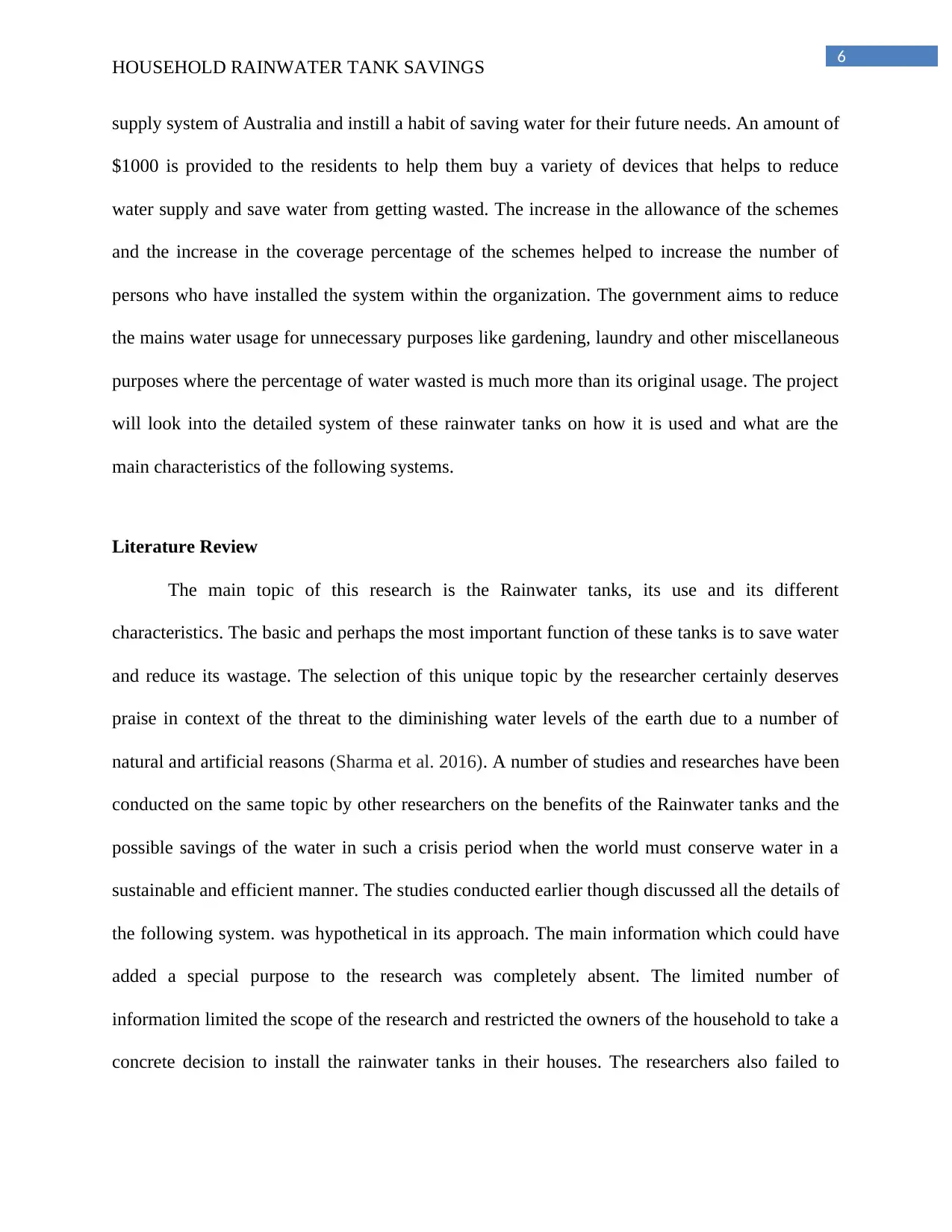
6
HOUSEHOLD RAINWATER TANK SAVINGS
supply system of Australia and instill a habit of saving water for their future needs. An amount of
$1000 is provided to the residents to help them buy a variety of devices that helps to reduce
water supply and save water from getting wasted. The increase in the allowance of the schemes
and the increase in the coverage percentage of the schemes helped to increase the number of
persons who have installed the system within the organization. The government aims to reduce
the mains water usage for unnecessary purposes like gardening, laundry and other miscellaneous
purposes where the percentage of water wasted is much more than its original usage. The project
will look into the detailed system of these rainwater tanks on how it is used and what are the
main characteristics of the following systems.
Literature Review
The main topic of this research is the Rainwater tanks, its use and its different
characteristics. The basic and perhaps the most important function of these tanks is to save water
and reduce its wastage. The selection of this unique topic by the researcher certainly deserves
praise in context of the threat to the diminishing water levels of the earth due to a number of
natural and artificial reasons (Sharma et al. 2016). A number of studies and researches have been
conducted on the same topic by other researchers on the benefits of the Rainwater tanks and the
possible savings of the water in such a crisis period when the world must conserve water in a
sustainable and efficient manner. The studies conducted earlier though discussed all the details of
the following system. was hypothetical in its approach. The main information which could have
added a special purpose to the research was completely absent. The limited number of
information limited the scope of the research and restricted the owners of the household to take a
concrete decision to install the rainwater tanks in their houses. The researchers also failed to
HOUSEHOLD RAINWATER TANK SAVINGS
supply system of Australia and instill a habit of saving water for their future needs. An amount of
$1000 is provided to the residents to help them buy a variety of devices that helps to reduce
water supply and save water from getting wasted. The increase in the allowance of the schemes
and the increase in the coverage percentage of the schemes helped to increase the number of
persons who have installed the system within the organization. The government aims to reduce
the mains water usage for unnecessary purposes like gardening, laundry and other miscellaneous
purposes where the percentage of water wasted is much more than its original usage. The project
will look into the detailed system of these rainwater tanks on how it is used and what are the
main characteristics of the following systems.
Literature Review
The main topic of this research is the Rainwater tanks, its use and its different
characteristics. The basic and perhaps the most important function of these tanks is to save water
and reduce its wastage. The selection of this unique topic by the researcher certainly deserves
praise in context of the threat to the diminishing water levels of the earth due to a number of
natural and artificial reasons (Sharma et al. 2016). A number of studies and researches have been
conducted on the same topic by other researchers on the benefits of the Rainwater tanks and the
possible savings of the water in such a crisis period when the world must conserve water in a
sustainable and efficient manner. The studies conducted earlier though discussed all the details of
the following system. was hypothetical in its approach. The main information which could have
added a special purpose to the research was completely absent. The limited number of
information limited the scope of the research and restricted the owners of the household to take a
concrete decision to install the rainwater tanks in their houses. The researchers also failed to
⊘ This is a preview!⊘
Do you want full access?
Subscribe today to unlock all pages.

Trusted by 1+ million students worldwide
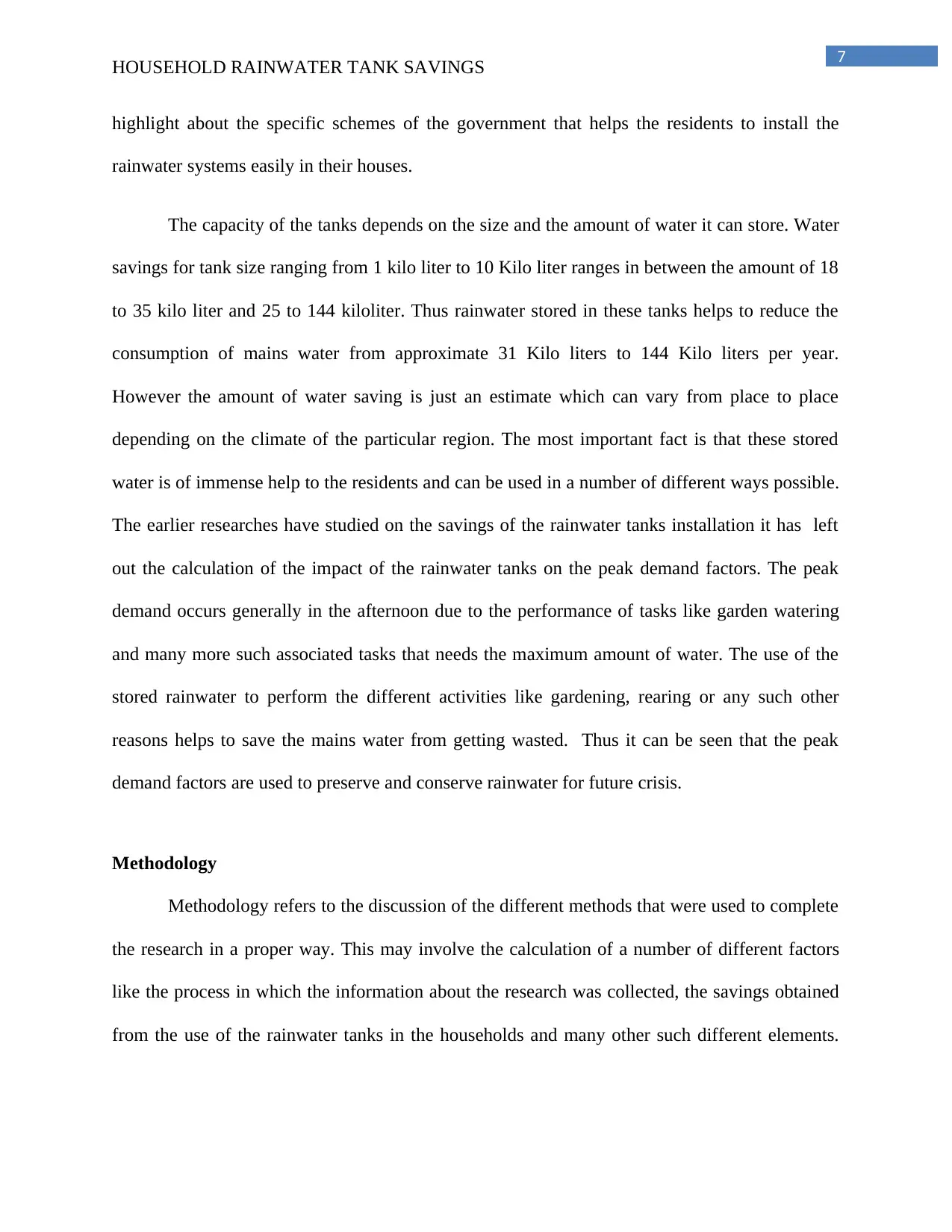
7
HOUSEHOLD RAINWATER TANK SAVINGS
highlight about the specific schemes of the government that helps the residents to install the
rainwater systems easily in their houses.
The capacity of the tanks depends on the size and the amount of water it can store. Water
savings for tank size ranging from 1 kilo liter to 10 Kilo liter ranges in between the amount of 18
to 35 kilo liter and 25 to 144 kiloliter. Thus rainwater stored in these tanks helps to reduce the
consumption of mains water from approximate 31 Kilo liters to 144 Kilo liters per year.
However the amount of water saving is just an estimate which can vary from place to place
depending on the climate of the particular region. The most important fact is that these stored
water is of immense help to the residents and can be used in a number of different ways possible.
The earlier researches have studied on the savings of the rainwater tanks installation it has left
out the calculation of the impact of the rainwater tanks on the peak demand factors. The peak
demand occurs generally in the afternoon due to the performance of tasks like garden watering
and many more such associated tasks that needs the maximum amount of water. The use of the
stored rainwater to perform the different activities like gardening, rearing or any such other
reasons helps to save the mains water from getting wasted. Thus it can be seen that the peak
demand factors are used to preserve and conserve rainwater for future crisis.
Methodology
Methodology refers to the discussion of the different methods that were used to complete
the research in a proper way. This may involve the calculation of a number of different factors
like the process in which the information about the research was collected, the savings obtained
from the use of the rainwater tanks in the households and many other such different elements.
HOUSEHOLD RAINWATER TANK SAVINGS
highlight about the specific schemes of the government that helps the residents to install the
rainwater systems easily in their houses.
The capacity of the tanks depends on the size and the amount of water it can store. Water
savings for tank size ranging from 1 kilo liter to 10 Kilo liter ranges in between the amount of 18
to 35 kilo liter and 25 to 144 kiloliter. Thus rainwater stored in these tanks helps to reduce the
consumption of mains water from approximate 31 Kilo liters to 144 Kilo liters per year.
However the amount of water saving is just an estimate which can vary from place to place
depending on the climate of the particular region. The most important fact is that these stored
water is of immense help to the residents and can be used in a number of different ways possible.
The earlier researches have studied on the savings of the rainwater tanks installation it has left
out the calculation of the impact of the rainwater tanks on the peak demand factors. The peak
demand occurs generally in the afternoon due to the performance of tasks like garden watering
and many more such associated tasks that needs the maximum amount of water. The use of the
stored rainwater to perform the different activities like gardening, rearing or any such other
reasons helps to save the mains water from getting wasted. Thus it can be seen that the peak
demand factors are used to preserve and conserve rainwater for future crisis.
Methodology
Methodology refers to the discussion of the different methods that were used to complete
the research in a proper way. This may involve the calculation of a number of different factors
like the process in which the information about the research was collected, the savings obtained
from the use of the rainwater tanks in the households and many other such different elements.
Paraphrase This Document
Need a fresh take? Get an instant paraphrase of this document with our AI Paraphraser
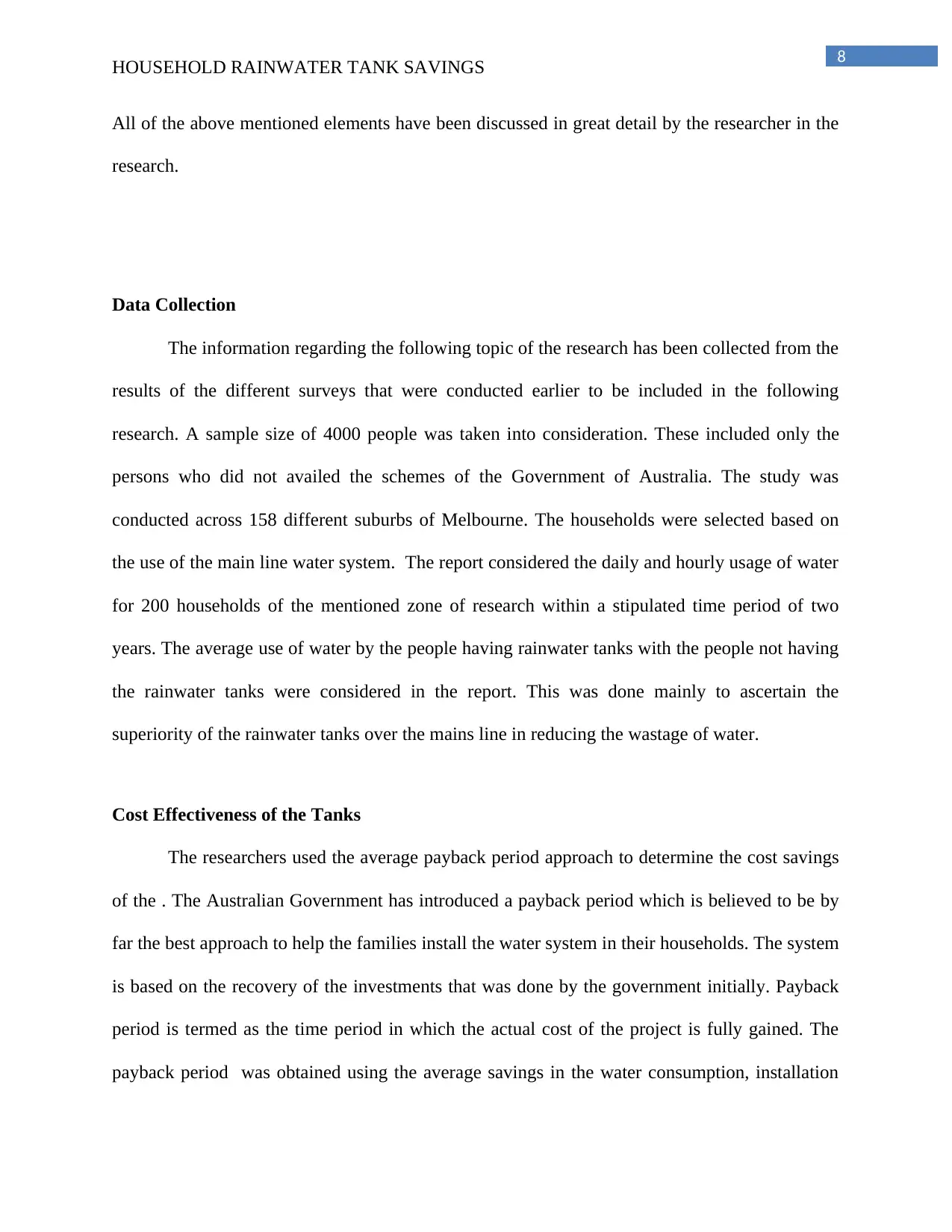
8
HOUSEHOLD RAINWATER TANK SAVINGS
All of the above mentioned elements have been discussed in great detail by the researcher in the
research.
Data Collection
The information regarding the following topic of the research has been collected from the
results of the different surveys that were conducted earlier to be included in the following
research. A sample size of 4000 people was taken into consideration. These included only the
persons who did not availed the schemes of the Government of Australia. The study was
conducted across 158 different suburbs of Melbourne. The households were selected based on
the use of the main line water system. The report considered the daily and hourly usage of water
for 200 households of the mentioned zone of research within a stipulated time period of two
years. The average use of water by the people having rainwater tanks with the people not having
the rainwater tanks were considered in the report. This was done mainly to ascertain the
superiority of the rainwater tanks over the mains line in reducing the wastage of water.
Cost Effectiveness of the Tanks
The researchers used the average payback period approach to determine the cost savings
of the . The Australian Government has introduced a payback period which is believed to be by
far the best approach to help the families install the water system in their households. The system
is based on the recovery of the investments that was done by the government initially. Payback
period is termed as the time period in which the actual cost of the project is fully gained. The
payback period was obtained using the average savings in the water consumption, installation
HOUSEHOLD RAINWATER TANK SAVINGS
All of the above mentioned elements have been discussed in great detail by the researcher in the
research.
Data Collection
The information regarding the following topic of the research has been collected from the
results of the different surveys that were conducted earlier to be included in the following
research. A sample size of 4000 people was taken into consideration. These included only the
persons who did not availed the schemes of the Government of Australia. The study was
conducted across 158 different suburbs of Melbourne. The households were selected based on
the use of the main line water system. The report considered the daily and hourly usage of water
for 200 households of the mentioned zone of research within a stipulated time period of two
years. The average use of water by the people having rainwater tanks with the people not having
the rainwater tanks were considered in the report. This was done mainly to ascertain the
superiority of the rainwater tanks over the mains line in reducing the wastage of water.
Cost Effectiveness of the Tanks
The researchers used the average payback period approach to determine the cost savings
of the . The Australian Government has introduced a payback period which is believed to be by
far the best approach to help the families install the water system in their households. The system
is based on the recovery of the investments that was done by the government initially. Payback
period is termed as the time period in which the actual cost of the project is fully gained. The
payback period was obtained using the average savings in the water consumption, installation
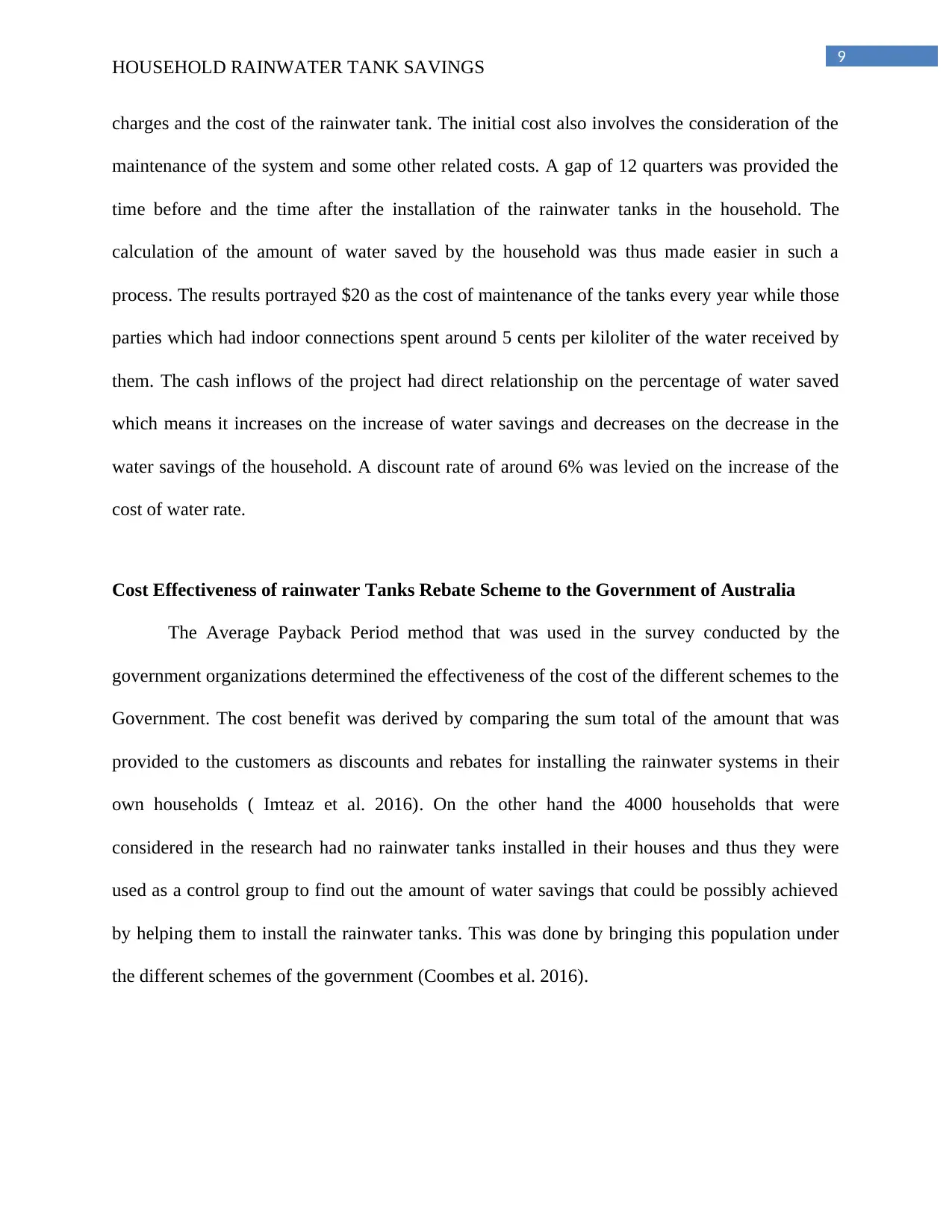
9
HOUSEHOLD RAINWATER TANK SAVINGS
charges and the cost of the rainwater tank. The initial cost also involves the consideration of the
maintenance of the system and some other related costs. A gap of 12 quarters was provided the
time before and the time after the installation of the rainwater tanks in the household. The
calculation of the amount of water saved by the household was thus made easier in such a
process. The results portrayed $20 as the cost of maintenance of the tanks every year while those
parties which had indoor connections spent around 5 cents per kiloliter of the water received by
them. The cash inflows of the project had direct relationship on the percentage of water saved
which means it increases on the increase of water savings and decreases on the decrease in the
water savings of the household. A discount rate of around 6% was levied on the increase of the
cost of water rate.
Cost Effectiveness of rainwater Tanks Rebate Scheme to the Government of Australia
The Average Payback Period method that was used in the survey conducted by the
government organizations determined the effectiveness of the cost of the different schemes to the
Government. The cost benefit was derived by comparing the sum total of the amount that was
provided to the customers as discounts and rebates for installing the rainwater systems in their
own households ( Imteaz et al. 2016). On the other hand the 4000 households that were
considered in the research had no rainwater tanks installed in their houses and thus they were
used as a control group to find out the amount of water savings that could be possibly achieved
by helping them to install the rainwater tanks. This was done by bringing this population under
the different schemes of the government (Coombes et al. 2016).
HOUSEHOLD RAINWATER TANK SAVINGS
charges and the cost of the rainwater tank. The initial cost also involves the consideration of the
maintenance of the system and some other related costs. A gap of 12 quarters was provided the
time before and the time after the installation of the rainwater tanks in the household. The
calculation of the amount of water saved by the household was thus made easier in such a
process. The results portrayed $20 as the cost of maintenance of the tanks every year while those
parties which had indoor connections spent around 5 cents per kiloliter of the water received by
them. The cash inflows of the project had direct relationship on the percentage of water saved
which means it increases on the increase of water savings and decreases on the decrease in the
water savings of the household. A discount rate of around 6% was levied on the increase of the
cost of water rate.
Cost Effectiveness of rainwater Tanks Rebate Scheme to the Government of Australia
The Average Payback Period method that was used in the survey conducted by the
government organizations determined the effectiveness of the cost of the different schemes to the
Government. The cost benefit was derived by comparing the sum total of the amount that was
provided to the customers as discounts and rebates for installing the rainwater systems in their
own households ( Imteaz et al. 2016). On the other hand the 4000 households that were
considered in the research had no rainwater tanks installed in their houses and thus they were
used as a control group to find out the amount of water savings that could be possibly achieved
by helping them to install the rainwater tanks. This was done by bringing this population under
the different schemes of the government (Coombes et al. 2016).
⊘ This is a preview!⊘
Do you want full access?
Subscribe today to unlock all pages.

Trusted by 1+ million students worldwide
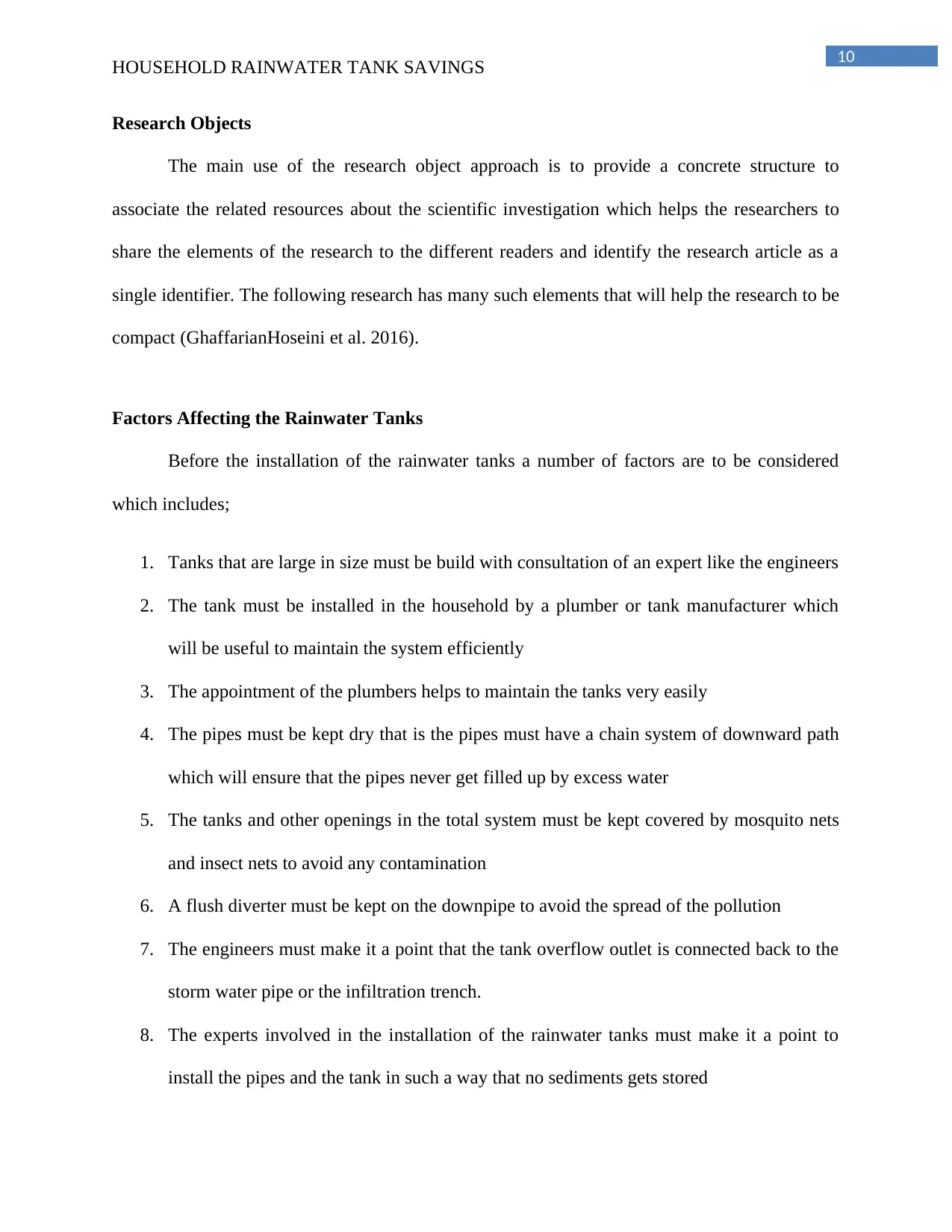
10
HOUSEHOLD RAINWATER TANK SAVINGS
Research Objects
The main use of the research object approach is to provide a concrete structure to
associate the related resources about the scientific investigation which helps the researchers to
share the elements of the research to the different readers and identify the research article as a
single identifier. The following research has many such elements that will help the research to be
compact (GhaffarianHoseini et al. 2016).
Factors Affecting the Rainwater Tanks
Before the installation of the rainwater tanks a number of factors are to be considered
which includes;
1. Tanks that are large in size must be build with consultation of an expert like the engineers
2. The tank must be installed in the household by a plumber or tank manufacturer which
will be useful to maintain the system efficiently
3. The appointment of the plumbers helps to maintain the tanks very easily
4. The pipes must be kept dry that is the pipes must have a chain system of downward path
which will ensure that the pipes never get filled up by excess water
5. The tanks and other openings in the total system must be kept covered by mosquito nets
and insect nets to avoid any contamination
6. A flush diverter must be kept on the downpipe to avoid the spread of the pollution
7. The engineers must make it a point that the tank overflow outlet is connected back to the
storm water pipe or the infiltration trench.
8. The experts involved in the installation of the rainwater tanks must make it a point to
install the pipes and the tank in such a way that no sediments gets stored
HOUSEHOLD RAINWATER TANK SAVINGS
Research Objects
The main use of the research object approach is to provide a concrete structure to
associate the related resources about the scientific investigation which helps the researchers to
share the elements of the research to the different readers and identify the research article as a
single identifier. The following research has many such elements that will help the research to be
compact (GhaffarianHoseini et al. 2016).
Factors Affecting the Rainwater Tanks
Before the installation of the rainwater tanks a number of factors are to be considered
which includes;
1. Tanks that are large in size must be build with consultation of an expert like the engineers
2. The tank must be installed in the household by a plumber or tank manufacturer which
will be useful to maintain the system efficiently
3. The appointment of the plumbers helps to maintain the tanks very easily
4. The pipes must be kept dry that is the pipes must have a chain system of downward path
which will ensure that the pipes never get filled up by excess water
5. The tanks and other openings in the total system must be kept covered by mosquito nets
and insect nets to avoid any contamination
6. A flush diverter must be kept on the downpipe to avoid the spread of the pollution
7. The engineers must make it a point that the tank overflow outlet is connected back to the
storm water pipe or the infiltration trench.
8. The experts involved in the installation of the rainwater tanks must make it a point to
install the pipes and the tank in such a way that no sediments gets stored
Paraphrase This Document
Need a fresh take? Get an instant paraphrase of this document with our AI Paraphraser
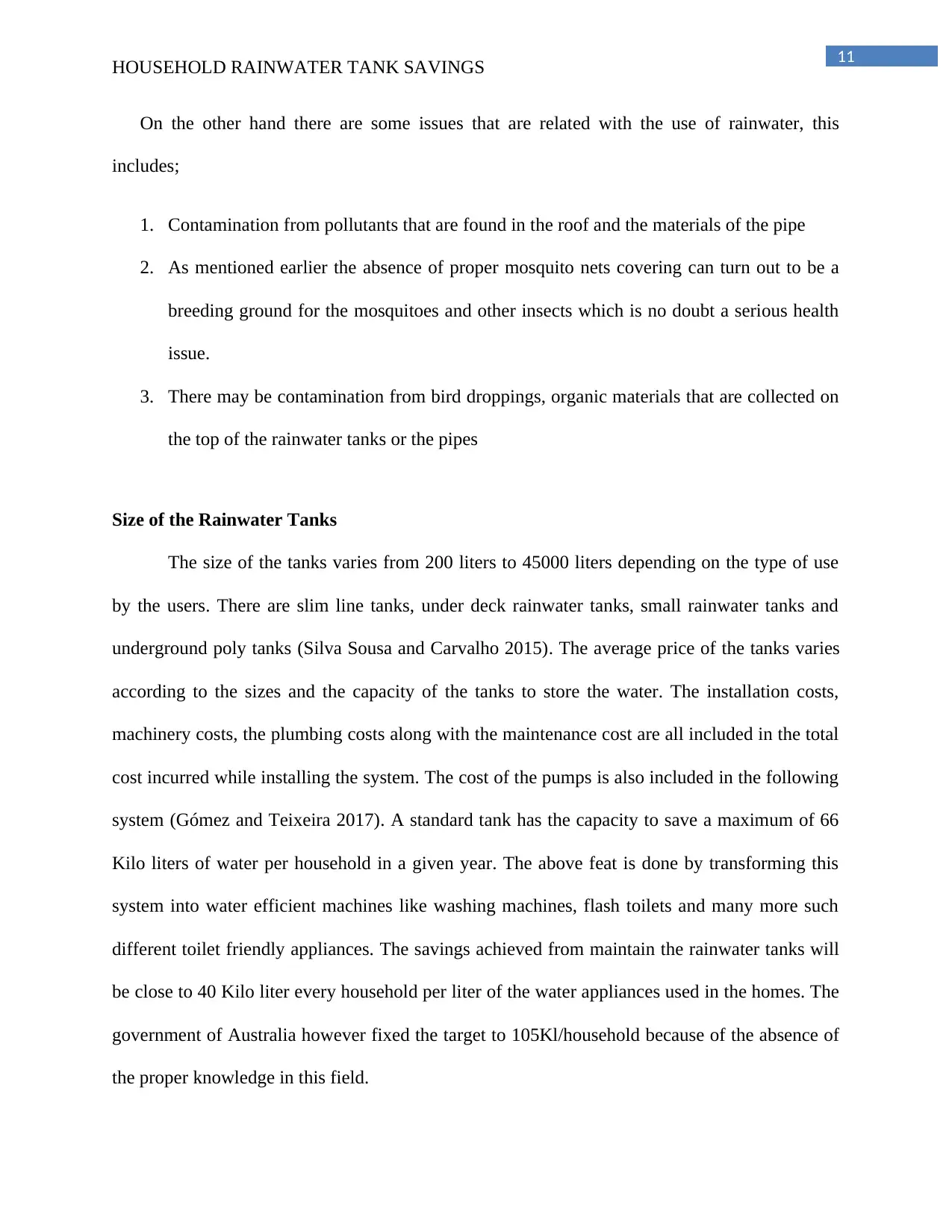
11
HOUSEHOLD RAINWATER TANK SAVINGS
On the other hand there are some issues that are related with the use of rainwater, this
includes;
1. Contamination from pollutants that are found in the roof and the materials of the pipe
2. As mentioned earlier the absence of proper mosquito nets covering can turn out to be a
breeding ground for the mosquitoes and other insects which is no doubt a serious health
issue.
3. There may be contamination from bird droppings, organic materials that are collected on
the top of the rainwater tanks or the pipes
Size of the Rainwater Tanks
The size of the tanks varies from 200 liters to 45000 liters depending on the type of use
by the users. There are slim line tanks, under deck rainwater tanks, small rainwater tanks and
underground poly tanks (Silva Sousa and Carvalho 2015). The average price of the tanks varies
according to the sizes and the capacity of the tanks to store the water. The installation costs,
machinery costs, the plumbing costs along with the maintenance cost are all included in the total
cost incurred while installing the system. The cost of the pumps is also included in the following
system (Gómez and Teixeira 2017). A standard tank has the capacity to save a maximum of 66
Kilo liters of water per household in a given year. The above feat is done by transforming this
system into water efficient machines like washing machines, flash toilets and many more such
different toilet friendly appliances. The savings achieved from maintain the rainwater tanks will
be close to 40 Kilo liter every household per liter of the water appliances used in the homes. The
government of Australia however fixed the target to 105Kl/household because of the absence of
the proper knowledge in this field.
HOUSEHOLD RAINWATER TANK SAVINGS
On the other hand there are some issues that are related with the use of rainwater, this
includes;
1. Contamination from pollutants that are found in the roof and the materials of the pipe
2. As mentioned earlier the absence of proper mosquito nets covering can turn out to be a
breeding ground for the mosquitoes and other insects which is no doubt a serious health
issue.
3. There may be contamination from bird droppings, organic materials that are collected on
the top of the rainwater tanks or the pipes
Size of the Rainwater Tanks
The size of the tanks varies from 200 liters to 45000 liters depending on the type of use
by the users. There are slim line tanks, under deck rainwater tanks, small rainwater tanks and
underground poly tanks (Silva Sousa and Carvalho 2015). The average price of the tanks varies
according to the sizes and the capacity of the tanks to store the water. The installation costs,
machinery costs, the plumbing costs along with the maintenance cost are all included in the total
cost incurred while installing the system. The cost of the pumps is also included in the following
system (Gómez and Teixeira 2017). A standard tank has the capacity to save a maximum of 66
Kilo liters of water per household in a given year. The above feat is done by transforming this
system into water efficient machines like washing machines, flash toilets and many more such
different toilet friendly appliances. The savings achieved from maintain the rainwater tanks will
be close to 40 Kilo liter every household per liter of the water appliances used in the homes. The
government of Australia however fixed the target to 105Kl/household because of the absence of
the proper knowledge in this field.
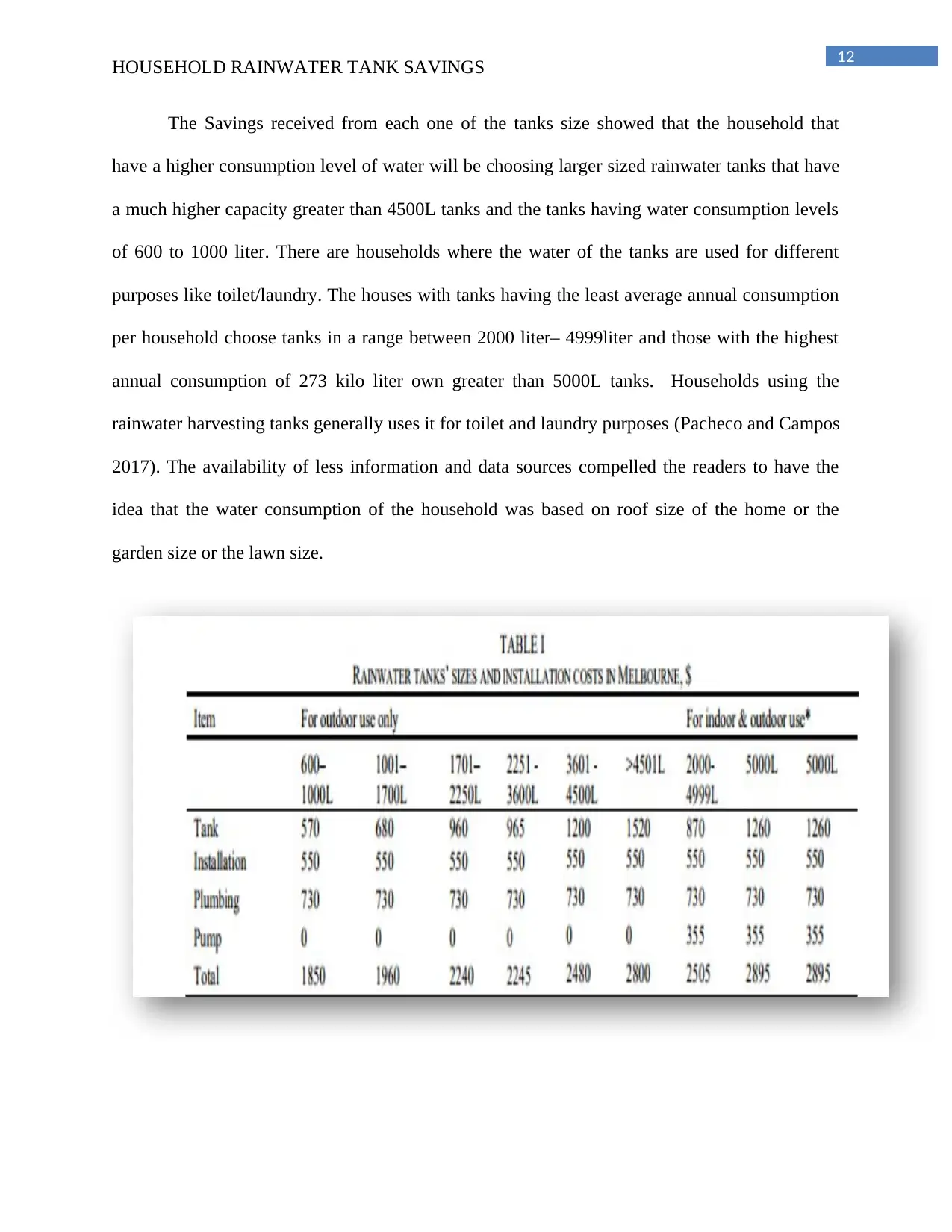
12
HOUSEHOLD RAINWATER TANK SAVINGS
The Savings received from each one of the tanks size showed that the household that
have a higher consumption level of water will be choosing larger sized rainwater tanks that have
a much higher capacity greater than 4500L tanks and the tanks having water consumption levels
of 600 to 1000 liter. There are households where the water of the tanks are used for different
purposes like toilet/laundry. The houses with tanks having the least average annual consumption
per household choose tanks in a range between 2000 liter– 4999liter and those with the highest
annual consumption of 273 kilo liter own greater than 5000L tanks. Households using the
rainwater harvesting tanks generally uses it for toilet and laundry purposes (Pacheco and Campos
2017). The availability of less information and data sources compelled the readers to have the
idea that the water consumption of the household was based on roof size of the home or the
garden size or the lawn size.
HOUSEHOLD RAINWATER TANK SAVINGS
The Savings received from each one of the tanks size showed that the household that
have a higher consumption level of water will be choosing larger sized rainwater tanks that have
a much higher capacity greater than 4500L tanks and the tanks having water consumption levels
of 600 to 1000 liter. There are households where the water of the tanks are used for different
purposes like toilet/laundry. The houses with tanks having the least average annual consumption
per household choose tanks in a range between 2000 liter– 4999liter and those with the highest
annual consumption of 273 kilo liter own greater than 5000L tanks. Households using the
rainwater harvesting tanks generally uses it for toilet and laundry purposes (Pacheco and Campos
2017). The availability of less information and data sources compelled the readers to have the
idea that the water consumption of the household was based on roof size of the home or the
garden size or the lawn size.
⊘ This is a preview!⊘
Do you want full access?
Subscribe today to unlock all pages.

Trusted by 1+ million students worldwide
1 out of 33
Related Documents
Your All-in-One AI-Powered Toolkit for Academic Success.
+13062052269
info@desklib.com
Available 24*7 on WhatsApp / Email
![[object Object]](/_next/static/media/star-bottom.7253800d.svg)
Unlock your academic potential
Copyright © 2020–2025 A2Z Services. All Rights Reserved. Developed and managed by ZUCOL.





